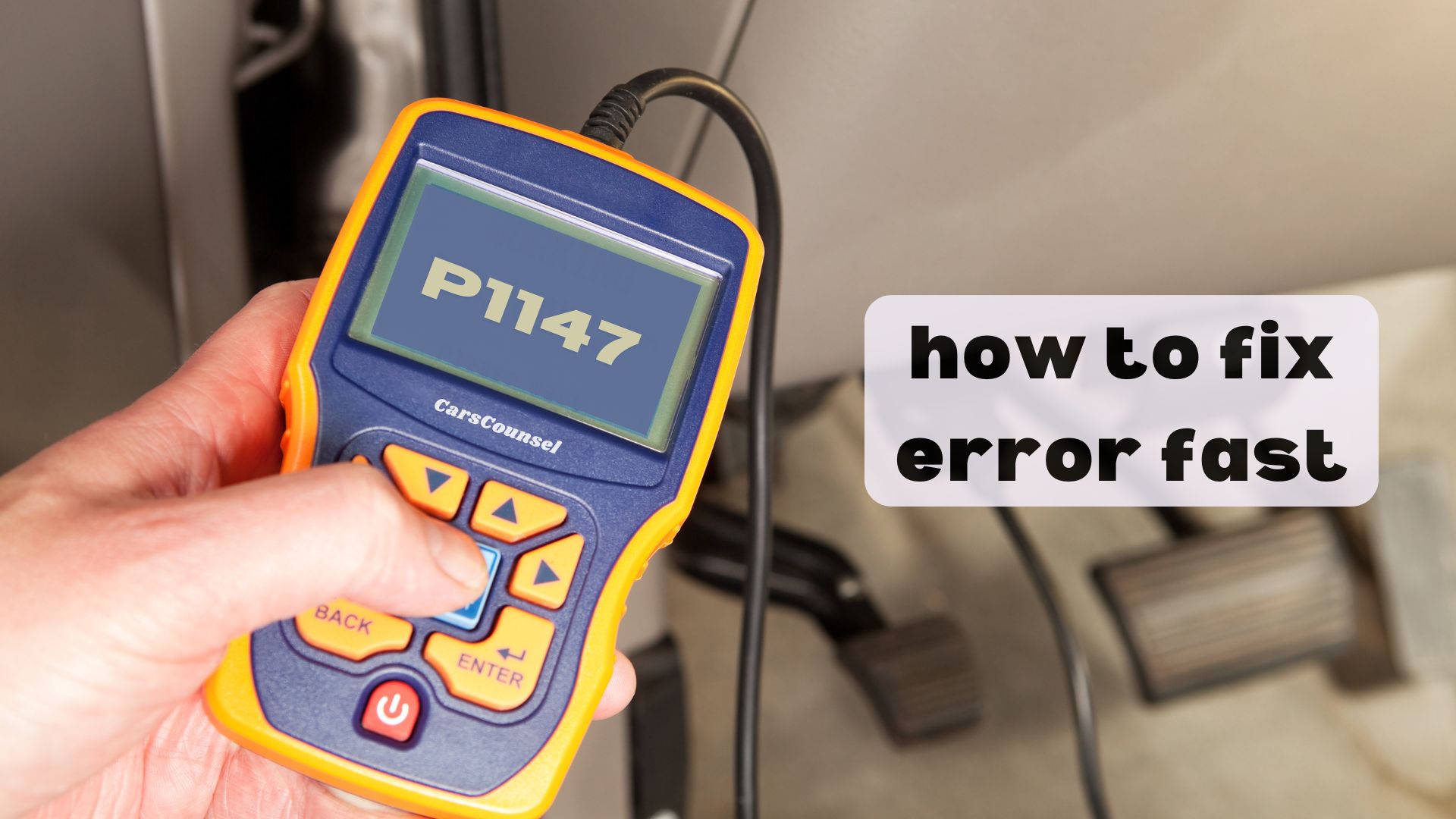As you’re scanning your dashboard, you notice the check engine light is on, and the code P1147 pops up. What does it mean? Fundamentally, your vehicle’s onboard computer is telling you that the Heated Oxygen Sensor 2 in Bank 1 is detecting a voltage level higher than expected.
This sensor plays a vital role in monitoring oxygen levels in the exhaust gases, and an incorrect reading can lead to poor fuel efficiency, increased emissions, and even engine damage.
You’ll want to investigate further to prevent any long-term consequences.

Quick Navigation
Key Takeaways
- P1147 code indicates a problem with the Heated Oxygen Sensor 2 in Bank 1, detecting voltage levels higher than expected.
- This can lead to an incorrect air-fuel mixture, resulting in poor fuel efficiency, increased emissions, and potentially damaging the engine.
- Common causes include sensor failure, wiring or connector issues, exhaust leaks, engine running too rich, and a faulty catalytic converter.
- Symptoms of P1147 include decreased fuel efficiency, rough idling or engine stalling, Check Engine Light illuminated, poor engine performance, and increased emissions.
- Repair estimates for fixing P1147 code range from $200 to $400, including parts and labor, depending on the specific cause and vehicle make and model.
Code P1147 Description and Causes
The P1147 code indicates a problem with the Heated Oxygen Sensor 2 in Bank 1 of your vehicle.
This sensor monitors oxygen levels in the exhaust gases after they’ve passed through the catalytic converter.
The maximum voltage monitoring aspect of the error code suggests the sensor is detecting a voltage level higher than expected.
This can lead to an incorrect air-fuel mixture, resulting in poor fuel efficiency, increased emissions, and potentially damaging the engine.
Common causes include sensor failure, wiring or connector issues, exhaust leaks, engine running too rich, and a faulty catalytic converter.
Symptoms of P1147
When your vehicle’s onboard computer triggers a P1147 code, it’s likely you’ll notice some telltale signs that something’s amiss.
You might experience decreased fuel efficiency, which can hit your wallet hard.
Additionally, your engine performance may suffer, leading to rough idling or even stalling.
Here are some common symptoms to watch out for:
- Decreased fuel efficiency
- Rough idling or engine stalling
- Check Engine Light illuminated
How to Fix P1147
Typically, diagnosing and fixing a P1147 code requires a methodical approach to identify the root cause of the issue.
You’ll need to verify the code using a scan tool and determine if the Heated Oxygen Sensor 2 is faulty.
Inspect the wiring and connectors for damage or corrosion, repairing or replacing as necessary.
Check for exhaust leaks and repair them if found.
If sensor troubleshooting reveals a faulty sensor, Oxygen sensor replacement is likely necessary.
After repairs, clear the code and test the system to confirm the issue is resolved.
Cost to Fix P1147 and Additional Information
You’ve successfully diagnosed and fixed the P1147 code, but now it’s time to weigh the financial impact of the repair.
The cost of fixing a P1147 code can vary depending on the specific cause and your vehicle’s make and model.
Now, ponder the following estimates and additional information to ponder:
- Repair estimates: $200 to $400 for a new Heated Oxygen Sensor 2, including parts and labor
- Additional costs may be incurred if other components need to be repaired or replaced
- Diagnostic tools, such as scan tools, can help you identify the root cause of the issue and provide a more accurate repair estimate
What Is the Heated Oxygen Sensor 2
The Heated Oxygen Sensor 2, located in Bank 1 of your vehicle, plays a vital role in ensuring your engine runs efficiently and minimizes its environmental impact.
This sensor’s primary function is to monitor oxygen levels in the exhaust gases after they’ve passed through the catalytic converter.
It helps your engine control unit adjust the air-fuel mixture, ensuring ideal combustion and reducing emissions.
The Heated Oxygen Sensor 2 is responsible for detecting oxygen levels, which allows your engine to fine-tune its performance and reduce its ecological footprint.
Its accurate sensor function is pivotal for maintaining a healthy engine and environment.
Common Causes of P1147
Faulty components, wiring issues, and engine problems can all trigger the P1147 code.
You’ll want to investigate several potential causes to determine the root of the issue.
Some common culprits include:
- Sensor Failure: A faulty Heated Oxygen Sensor 2 can cause the code to appear, leading to an Oxygen Imbalance and incorrect air-fuel mixture.
- Wiring or connector issues: Damage or corrosion in the wiring or connectors can prevent the sensor from functioning properly.
- Engine running too rich: An overly rich fuel mixture can also trigger the P1147 code, as it can cause the oxygen sensor to detect excessive voltage.
Diagnosing the Root Cause of P1147
Diagnosing the root cause of P1147 code requires a systematic approach to identify the culprit behind the issue. You’ll need to rule out potential causes one by one to guarantee accurate diagnosis. Start by checking the Heated Oxygen Sensor 2 for signs of sensor failure or voltage fluctuation. Then, inspect the wiring and connectors for damage or corrosion.
| Potential Cause | Symptoms | Action |
|---|---|---|
| Sensor Failure | High voltage readings, incorrect air-fuel mixture | Replace Heated Oxygen Sensor 2 |
| Wiring or Connector Issues | Intermittent voltage readings, corrosion | Repair or replace wiring and connectors |
| Exhaust Leaks | High voltage readings, decreased fuel efficiency | Repair exhaust leaks |
| Engine Running Rich | High voltage readings, decreased fuel efficiency | Adjust engine calibration |
| Faulty Catalytic Converter | High voltage readings, increased emissions | Replace catalytic converter |
Risks of Ignoring P1147 Code
Ignoring the P1147 code can lead to more severe issues down the road.
You may think it’s just a minor problem, but neglecting to address it can cause significant damage to your vehicle.
- Decreased fuel efficiency, which can lead to higher fuel costs and increased emissions
- Engine damage, which can result in costly repairs or even require a new engine
- Further damage to other components, such as the catalytic converter, which can lead to additional repair costs
More OBD-II Codes
| P1148 | P1149 | P1150 | P1032 |
| P1153 | P1154 | P1336 | P1352 |
| P1361 | P1362 | P1380 | P1381 |
| P1404 | P1441 | P1546 | P1641 |
| P1651 | P1652 | P1655 | P1660 |
| P1661 | P1671 | P1672 | P1673 |
Frequently Asked Questions
Will a Faulty Heated Oxygen Sensor 2 Cause My Car to Fail Emissions?
Will a faulty oxygen sensor really slip under the radar during emissions testing? Yes, it can, but a faulty Heated Oxygen Sensor 2 will likely cause your car to fail, so consider sensor cleaning or Oxygen sensor replacement to avoid issues.
Can a Clogged Catalytic Converter Trigger the P1147 Code?
You’re wondering if a clogged catalytic converter can trigger the P1147 code. Yes, it can, as a converter malfunction can affect sensor accuracy, leading to incorrect voltage readings and potentially causing the code to set.
Will the Check Engine Light Always Come on With a P1147 Code?
When a faulty oxygen sensor affects sensor functionality, your OBD II system may trigger the Check Engine Light, but it’s not a guarantee; you might experience other symptoms like decreased fuel efficiency or rough idling before the light comes on.
Can Low Fuel Pressure Cause a P1147 Code to Be Triggered?
You’re wondering if low fuel pressure can trigger a P1147 code. While it’s unlikely, a faulty fuel pump can cause rich fuel mixtures, leading to incorrect sensor calibration, which might, in turn, trigger the code.
Will a P1147 Code Clear Itself if I Fix the Underlying Issue?
Did you know that 75% of OBDII codes are related to faulty oxygen sensors? If you fix the underlying issue, the P1147 code might clear itself, but it’s vital to recalibrate the sensor to guarantee precise voltage readings, as voltage fluctuations can persist even after repairs.
Conclusion
“Fast fixation is fundamental to forestall further frustrations. Failing to fix the faulty Heated Oxygen Sensor 2 can fan the flames of fuel inefficiency, foul emissions, and fatal engine flaws. Fix the faulty sensor, faulty wiring, or faulty catalytic converter to fend off frightening fuel bills and frustrating fix-it fees. Forfeit further frustration, fix P1147 now!”

